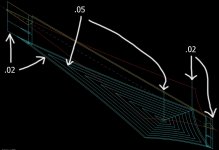I have a couple of questions on holding inlay material while you cut the male parts. What I have been doing is taking a piece of 3/16 material or slightly over and lightly gluing it with 5 min epoxy to another piece of wood that is help on my vacuum table. I was doing 1/8 inlays but found that they were a bit shallow so I do 3/16 and sometimes .25. Anyway what I do after I cut the male parts is to pry the inlay piece off, comes off rather easily and then sand the back until the pieces come out. Kind of a pain in the butt but I was hoping I could get a few other ideas, there must be a better way. Also how many thousands over do you make the butt before you inlay. Appreciate your input and thanks.
Happiness
Mark
Happiness
Mark
